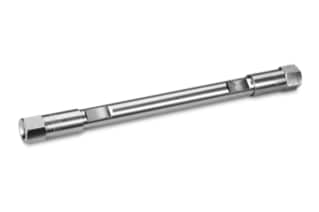
|
Chemistry |
C8 |
|
Separation Mode |
Reversed Phase |
|
Particle Substrate |
Silica |
|
pH Range Min |
2 pH |
|
pH Range Max |
8 pH |
|
Maximum Pressure |
6000 psi (415 Bar) |
|
Endcapped |
Yes |
|
Bonding Technology |
Shield RP8 |
|
Silanol Activity |
Low |
|
Particle Shape |
Spherical |
|
Particle Size |
3.5 µm |
|
Endfitting Type |
Waters |
|
Pore Size |
100 Å |
|
Format |
Column |
|
Surface Area |
335 |
|
System |
HPLC |
|
USP Classification |
L7 |
|
Inner Diameter |
4.6 mm |
|
Length |
100 mm |
|
Carbon Load |
15 % |
|
UNSPSC |
41115709 |
|
Brand |
Symmetry |
|
Product Type |
Columns |
|
Units per Package |
1 pk |

Symmetry Shield RP8 Column, 100Å, 3.5 µm, 4.6 mm X 100 mm, 1/pk
A high degree of reproducibility and complete confidence in the long-term compliance of your HPLC procedures are provided by symmetry columns. Waters' unique Embedded Polar Group Technology is used in Symmetry Shield Columns to protect residual silanols in silica from highly basic analytes and enhance peak shape. The activity of the surface silanols is further decreased by positioning the embedded polar group near the silica surface. When compared to the Symmetry C18 ligand, this imparts selectivity and retention that are different.
The embedded polar group technology developed by Waters is used in these reversed-phase columns to "shield" the leftover silanol surface from very basic analytes. Peak form and resolution are considerably enhanced by the SymmetryShield RP8 column's reduced silanol activity.
The Symmetry Shield RP8 Column, like all Waters products, is made in a cGMP, ISO 9001-certified facility with ultra-pure reagents. Our website has products to fulfill all of your analytical demands, such as columns, guards, vials, and elution plates. We offer a variety of brands and versions that are specifically developed to fulfill the needs of every sort of chromatographic analysis.
To discover the appropriate equipment for your lab needs, visit our website to shop for lab equipment directly. To ensure that you receive genuine Waters lab equipment and the lowest price on the market, we strongly advise you to purchase lab supplies directly from our website. Use the Waters catalog and website to read up on our most recent and prospective technological advancements.
You may also be interested in Symmetry Shield RP8 VanGuard Cartridge, 100Å, 3.5 µm, 3.9 mm X 5 mm, 3/pk; By eliminating particle pollution from the mobile phase stream, SymmetryShield RP8 VanGuard Cartridges are used to increase analytical column lifetime and performance. All 3.9 mm and 4.6 mm I.D. Symmetry Shield RP8 analytical columns with 3.5 µm sorbent particles are well-protected by this cartridge.
What Techniques Are Advisable For Isolating And Preparing Analytes?
To isolate and prepare sample components of interest, two common SPE techniques are used. When the concentrations of the target chemicals are too low for exact quantification, the retention-cleanup-elution approach is usually used. This method results in the concentration of diluted samples and trace enrichment of chemicals. If a high concentration of the desired sample component is present, a pass-through cleanup method may be used. However, when a pass-through cleanup approach is employed, there is no sample enrichment.